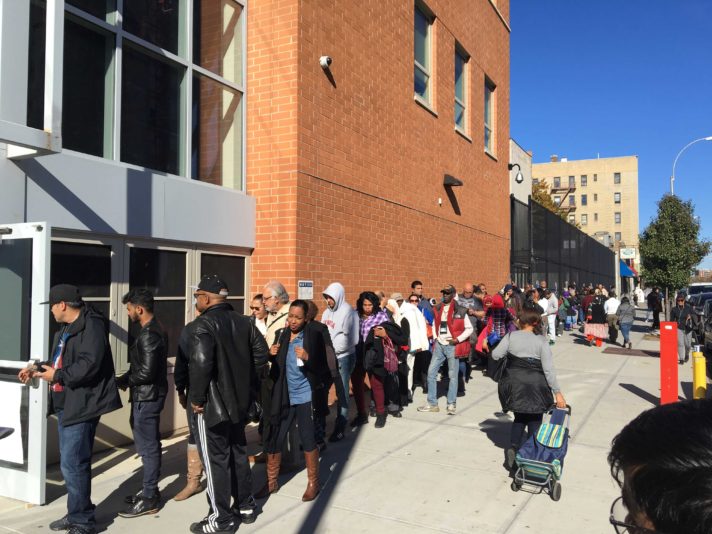Bronx Barriers: Low Voter Turnout

Voters Wait in Line
The Norwood News and WFUV continue their five-part series profiling different types of challenges impacting the Bronx.
Voter turnout remains a challenge during New York City elections. In the Bronx, that problem is amplified, consistently lagging when it comes to voter turnout, according to figures.
And with a mayoral election coming up later this year, it begs the question: Why aren’t more Bronx voters heading to the polls?
Multiple Challenges
It’s a question city Councilman Ritchie Torres of the 15th Council District had posed back in 2014. His answer: low civic engagement, with Bronx residents simply shrugging at the process.
“A lack of teaching civics is a real void in public education,” Torres said at a news conference in 2014 announcing funding to boost civic engagement among young people. “We have the lowest rates of voter participation and it’s no accident that the Bronx has more challenges than the rest of the city.”
Torres tied low civic engagement to low voter turnout, where a lack of valuing the process of resolution through participation has decreased attendance at the polls.
In the meantime, a consensus by those interviewed found their votes simply don’t count even as they cast them.
“Bronx voters are apathetic,” says Gail McLean, a long time resident of Kingsbridge Heights who votes regularly. “They’re not really believing the system works for them.”
Riverdale voters Rick and Danielle Bonaface agree. “There’s definitely a lot of apathy,” Danielle says. “Some people feel it’s already decided or that it doesn’t make a difference.”
State Assemblyman Jeffrey Dinowitz represents the 81st Assembly District, including Riverdale and Fieldston – two Bronx neighborhoods with high levels of civic engagement. He agrees with McLean to an extent.
“The fact that this year, the candidate who was elected President got almost three million fewer votes than the candidate that wasn’t could potentially jade some people,” says Dinowitz, referring to the presidential race between Donald Trump, a Republican, and Hillary Clinton, a Democrat. “But there is no reason people in the Bronx should feel that way more than people in areas with higher turnout.”
Instead, he points to more systemic issues, such as voter registration, where same-day registration doesn’t exist in New York. Instead, New Yorkers must register to vote at least 25 days before an election.
For New York primaries, that window is even tighter. According to the New York Board of Elections, one must change party affiliation 25 days before the last general election. For example, the deadline to register with a party for this year’s mayoral primaries in September was on Oct. 14, 2016 – nearly an entire year before that election.
These days, Torres thinks there’s more to it than institutional barriers. “I think if you remove these barriers, I think you can improve voter participation at least at the margins,” he says. “But again, the laws are the same every year and the voter participation varies. There’s something else at work. It’s not only cynicism, but a sense that local politics are less important than national politics.”
The numbers support his theory. Voter turnout during the mayoral and presidential elections in the Bronx stood at 19.8 percent and 52 percent respectively, well below the average when compared to the city’s overall voter turnout, with 26 percent of voter turnout for the presidential election and 52 percent for the mayoral race, according to figures from the New York City and New York State boards of election.
The Solution
Combating a mix of cynicism, laws, and a perceived lack of importance can be easier said than done, but there are solutions on the table.
One of them comes from Torres himself. He is the lead sponsor of a so-called “voter shaming” bill that would send eligible voters in New York voting history cards, showing when they voted in elections.
“The intent is to notify,” says Torres. “If you confront people about their voting records, they’re more likely to vote with greater frequency.”
More conventional efforts to increase voter turnout are under way. The Vote Better NY campaign supported state legislation that would approve early voting, same-day registration, and voter-friendly ballots.
“With initiatives like this, you make the process more accessible, then that makes everyone’s participation that much greater,” says Crystal Joseph, the vice president of the League of Women Voters in New York City, one of the groups behind the campaign.
Though the bills are pending, Dinowitz says voters need to do their part in pressuring legislators to pass the bills. “We have many problems in the Bronx,” he says. “And our ability to address those problems is related to how strong we are in terms of our votes.”

